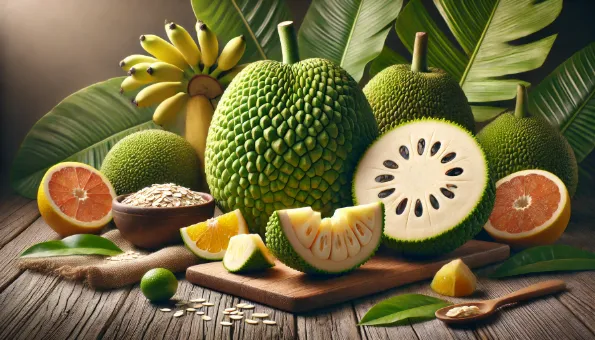Breadfruit: Tropical Gluten-Free Starchy Fruit Supplying Complex Carbs, Fiber, Potassium & Vitamin C
Versatile, potato-like immature fruit (Artocarpus altilis) roasted, boiled or fried; offers complex carbohydrates, fiber, potassium, vitamin C and sustainable food potential.

What Is Breadfruit?
Breadfruit (*Artocarpus altilis*) is a large **seeded or seedless tropical fruit** in the mulberry/jackfruit family. Immature (green/firm) it behaves like a **starchy staple (potato / bread substitute)**; ripe (soft, sweet, aromatic) it shifts toward dessert uses. Outer skin is green with polygonal, patterned sections; interior cream-white turning yellowish as it ripens.
Nutrition (per 100 g cooked, boiled unsalted)
| | Amount | Notes |
|---|---|---|
| Calories | 103 kcal | Moderate energy density |
| **Carbohydrate** | 27 g | Mainly starch; some forms retrograde on cooling (resistant) |
| – Fiber | 4–5 g | Insoluble + soluble (pectin) |
| **Protein** | 1.0–1.1 g | Limited (pair with legumes/fish) |
| Fat | 0.2 g | Very low |
| **Potassium** | 490–500 mg | Electrolyte support |
| **Vitamin C** | 20–25 mg | ~22–28% DV (declines with prolonged heat) |
| Magnesium | 25–30 mg | Nerve & muscle function |
| Small amounts | Calcium, iron, B vitamins | Not major sources |
Rich in **complex carbs + fiber**; naturally gluten-free & low in fat.
Potential Benefits
- **Complex carbohydrates + fiber** provide sustained energy & satiety vs refined starches.
- **Potassium + magnesium** support fluid balance and neuromuscular function.
- **Vitamin C & carotenoid precursors** (more in yellow, ripe flesh) contribute antioxidant capacity.
- **Low fat, gluten-free**; suitable base for celiac and many elimination diets when simply prepared.
- Forms **resistant starch** when cooked then cooled (e.g., chilled breadfruit salad) which may aid glycemic moderation & gut fermentation.
Drawbacks & Precautions
- **High glycemic potential** if eaten hot and mashed/fried (rapidly digestible starch) — combine with fiber/fat/protein to moderate.
- **Latex exudate** (sticky sap) when cutting green fruit can irritate skin; oil knife & hands or wear gloves.
- **Allergy/cross-reactivity** rare but possible with other Moraceae (jackfruit, figs) in latex-sensitive individuals.
- Deep-frying adds substantial calories & diminishes vitamin C.
- Overripe fruit can ferment quickly, developing off aromas if not used or processed.
Culinary Uses
- **Roasted / Baked (whole or wedges)**: Traditional ‘bread’ use; flesh becomes fluffy, mildly nutty.
- **Boiled / Steamed**: Cubes for curries, stews, salads (similar to potatoes or yams).
- **Fried / Chips**: Thin slices or wedges (moderate oil for lighter result; consider air-frying).
- **Mashed / Puréed**: With coconut milk, herbs or spices; base for patties or spreads.
- **Flour**: Dehydrated, milled — used in gluten-free baking blends (improves moisture retention, mild flavor).
- **Ripe (sweet)**: Pancakes, fritters, puddings, smoothies (banana substitute), fermented into beverages.
Preparation & Technique
- **Select**: Green-firm for savory; slight give & aromatic for sweet.
- **Peel & Core**: Quarter; remove central pith; oil knife to reduce sticking (latex). Blanching pieces briefly eases peeling.
- **Cook Thoroughly**: Starch fully gelatinizes when flesh turns uniformly soft but not waterlogged.
- **Steam or roast (dry heat)** for better micronutrient retention vs prolonged boiling.
- **Cool & chill** some cooked portions to increase resistant starch if targeting lower glycemic impact.
- **Flour**: Slice thin, dry (low oven/dehydrator) until brittle, mill, sift, store airtight.
Health Context & Pairings
- **Balance plate** by pairing breadfruit with **lean protein (fish, legumes) + healthy fat (coconut, olive) + vegetables** to moderate glycemic response.
- Portion (cooked): **½–1 cup (75–150 g)** as a starch component.
- For athletic recovery, combine hot roasted breadfruit (rapid starch) with a protein source.
- Cooling or using in salads improves **resistant starch** fraction (beneficial for gut microbiota fermentation).
Sustainability Notes
Breadfruit trees are **long-lived perennials** producing high yields with relatively low inputs once established, providing **food security & climate resilience** in tropical regions. They sequester carbon, reduce erosion with year-round canopy, and diversify agroforestry systems. Utilizing breadfruit flour can reduce import dependency on refined wheat in island communities.
Storage
Green fruit ripens at ambient temperature (2–5 days). Refrigerate ripe fruit (wrapped) and use within 2–3 days. Cooked breadfruit: refrigerate 3–4 days; freeze cubes or mash up to 3 months (blanch or par-cook to reduce texture loss). Breadfruit flour: airtight, cool, dry 6–9 months (refrigerate in humid climates).
Key Takeaways
✔︎ Sustainable, versatile gluten-free starch (fiber, potassium, vitamin C)
✔︎ Can lower glycemic impact via cooling/resistant starch & balanced meals
✖︎ High GI when hot & refined (e.g., fried chips); latex handling precautions needed.
- 1. Breadfruit
Used in dashi and other broths

